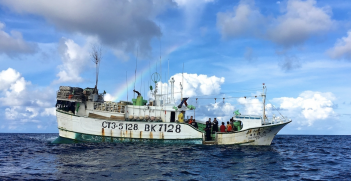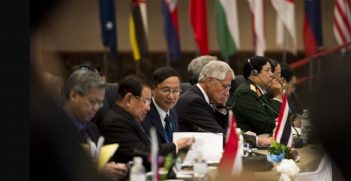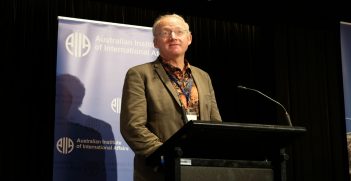Star Wars: The Battle for Laws Against War in Outer Space

On Monday, Chinese space station Tiangong-1 fell into to the Pacific Ocean after being out of control for the last two years. It’s a reminder that space is not yet a regulated space.
The successful launch in 1957 of the world’s first artificial satellite, Sputnik I, gave rise to the beginning of the space race. What had previously only been within the realm of the hypothetical was suddenly a reality and there was a need to regulate the exploration and use of outer space.
Since then, international law has developed to facilitate the use of technologies in a broad range of ways, with the diversity of space activities growing exponentially given the rapidly expanding capabilities of that technology. These include activities involving satellite telecommunications, global positioning systems, remote sensing technology for weather forecasting and disaster management, and television broadcast from satellites.
Cold War tensions
In this regard, space law has played a positive role by allowing for—and not unduly restricting—the development of space-related technology. At the same time, however, the existing legal regime has not prevented the development of military technology capable of using outer space. This was largely due to the fact that the early stages of human space activity coincided with a period of quite considerable Cold War tension. The possibility of large scale and potentially highly destructive military conflict between the (space) superpowers always lurked in the background. Indeed, the successful launch of Sputnik generated unease in the Western world because the technology used was similar to that used for ballistic missiles.
Although there are some restrictions, the five United Nations-sponsored space law treaties that have emerged from that period only proscribe military-related activities in relatively general terms which are open to varying interpretations as to what they do, and do not, prohibit, depending on one’s perspective.
This follows on from the fact that most space-related technology was initially conceived and developed through military eyes and for military goals. Only subsequently were they utilised for commercial and civil purposes as well. Their military utility remains ever present, although the reality is that space assets are increasingly used for terrestrial military activities. It is therefore crucial that efforts are made by the international community to regulate this new frontier in order to avoid a build-up of weapons and armed conflict in outer space itself.
Various initiatives, including the annual UN general assembly resolution on the Prevention of an Arms Race in Space (PAROS), are neither entirely clear nor sufficiently comprehensive to meet all of these challenges. The deployment of weapons of mass destruction in Earth’s orbit was banned under the treaties but this did not extend to other weapons or military systems.
Outer space for peaceful purposes
This deployment is seemingly inconsistent with the sentiment in the same 1967 treaty, known as the Outer Space Treaty, which promotes “the progress of the exploration and use of outer space for peaceful purposes”. The Outer Space Treaty also declares that the Moon and celestial bodies must be explored and used “exclusively for peaceful purposes”. Most space law scholars would interpret this as prohibiting military activities in outer space. However, this was not the view of those who actually had space capability. In fact, it is now clear that space has been used for military activities almost from the start of the space age.
Some of this may be termed passive military activities in outer space. This includes the provision of supporting communications, imaging and location assistance through satellite technology. But many countries are now increasingly using space technology as part of active engagement in the conduct of armed conflict on land, at sea and in the air in the terrestrial context. The use of GPS satellite-guided missiles is now commonplace in modern conflicts.
Even more worrying, recent technological trends have underlined that serious threats to global security exist even in this final frontier itself. This is due to the strategic value of outer space, the dependence of militaries and thus their vulnerability to an attack on their space assets and the belief by some (military) observers that a war in space is now ‘inevitable’.
Negotiating a stellar peace deal
We need to work very hard to dispel this notion of inevitability, which does risk becoming a self-fulfilling prophecy if care and restraint is not exercised.
In the absence of clear and binding rules, various attempts by lawyers, scientists, diplomats, military personnel and technicians to set out the rules that they (as experts) believe exist have been undertaken, albeit at relatively preliminary stages. What has become readily apparent, however, is that a clear divergence of viewpoints has emerged between those who believe in this inevitability as against those who believe that the ‘peaceful purposes’ doctrine must pervade all technological developments.
In (overly) simplistic terms, the former seem interested in rules that set out what can be done in space by way of military activities, arguing that “what is not expressly prohibited (by the treaties) is permitted”. The latter, on the other hand, are looking to confirm principles further restricting and limiting military engagement in space, arguing that the premise of the military-led groups significantly underestimates the importance of space to the survival of humanity as a whole.
In any event, what is required is clear and strong political will that will lead the major space powers—and indeed all of the international community—to the negotiating table to develop more specific and comprehensive binding rules that make it clear that space is and must remain a conflict-free zone if we are to avoid the unimaginable.
Steven Freeland is the Dean, School of Law and Professor of International Law, at Western Sydney University. This is an edited version of his remarks at AIIA NSW on 27 March.
This article is published under a Creative Commons Licence and may be republished with attribution.





